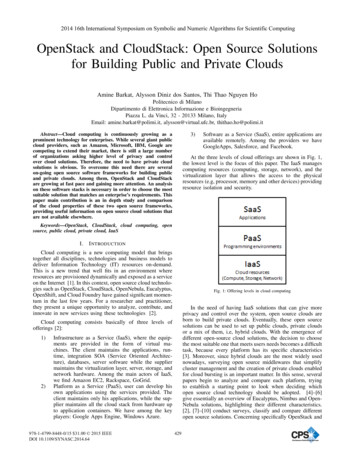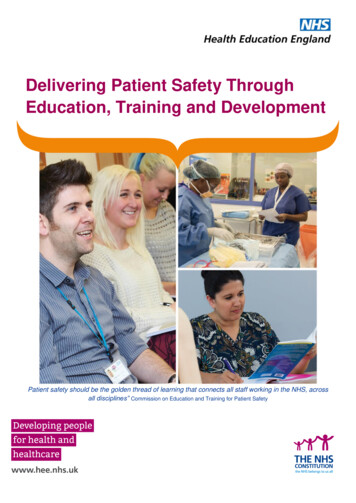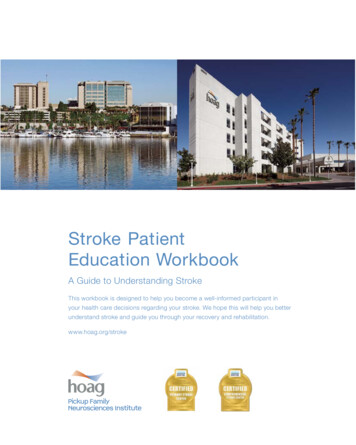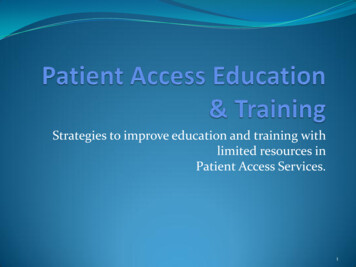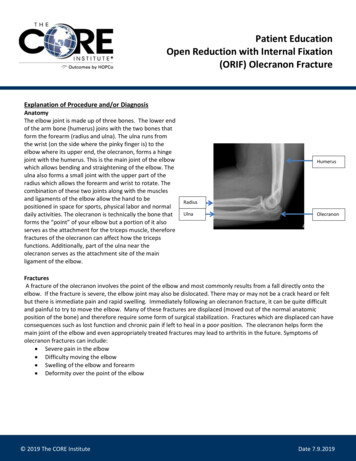
Transcription
Patient EducationOpen Reduction with Internal Fixation(ORIF) Olecranon FractureExplanation of Procedure and/or DiagnosisAnatomyThe elbow joint is made up of three bones. The lower endof the arm bone (humerus) joins with the two bones thatform the forearm (radius and ulna). The ulna runs fromthe wrist (on the side where the pinky finger is) to theelbow where its upper end, the olecranon, forms a hingejoint with the humerus. This is the main joint of the elbowwhich allows bending and straightening of the elbow. Theulna also forms a small joint with the upper part of theradius which allows the forearm and wrist to rotate. Thecombination of these two joints along with the musclesand ligaments of the elbow allow the hand to bepositioned in space for sports, physical labor and normaldaily activities. The olecranon is technically the bone thatforms the “point” of your elbow but a portion of it alsoserves as the attachment for the triceps muscle, thereforefractures of the olecranon can affect how the tricepsfunctions. Additionally, part of the ulna near theolecranon serves as the attachment site of the mainligament of the elbow.HumerusRadiusUlnaOlecranonFracturesA fracture of the olecranon involves the point of the elbow and most commonly results from a fall directly onto theelbow. If the fracture is severe, the elbow joint may also be dislocated. There may or may not be a crack heard or feltbut there is immediate pain and rapid swelling. Immediately following an olecranon fracture, it can be quite difficultand painful to try to move the elbow. Many of these fractures are displaced (moved out of the normal anatomicposition of the bone) and therefore require some form of surgical stabilization. Fractures which are displaced can haveconsequences such as lost function and chronic pain if left to heal in a poor position. The olecranon helps form themain joint of the elbow and even appropriately treated fractures may lead to arthritis in the future. Symptoms ofolecranon fractures can include: Severe pain in the elbow Difficulty moving the elbow Swelling of the elbow and forearm Deformity over the point of the elbow 2019 The CORE InstituteDate 7.9.2019
If you have an injury to your elbow that is resulting in pain or difficulty moving, it is prudent to proceed to anemergency room where initial treatment is given. The emergency room physician or your personal physician willusually recommend that you see an orthopedic surgeon. Typically, your initial orthopedic visit for an olecranonfracture will involve a history in which you describe the injury along with a limited exam of your wrist and elbow toensure there are no other injuries including injuries to the ligaments or nerves. X-rays are necessary to determine theseverity of the fracture and are usually done even if films were performed at an emergency room as the fragments canshift somewhat for the first few weeks after such an injury. In severe fractures, a CT scan may be necessary to betterdefine the severity and, in many cases, help determine whether or not surgery would be beneficial.Management of Olecranon FracturesThe initial management of an olecranon fracture involves: Immobilization with a sling and/or splint “Setting” the fracture is usually not necessary except in rare instances. Ice and pain medication Visit with an orthopedic surgeon within 3-5 days to assess need for further treatmentThe definitive management of your fracture will be determined by your orthopedic surgeon. The need for surgicalrepair of these fractures is based on the X-rays and CT scans when necessary. Because of the importance of theolecranon in forming the elbow joint, very little displacement can be accepted and therefore, surgical management isrecommended for many of these injuries. If not out of place, these can be treated non-surgically, typically with aperiod of immobilization in a cast of generally two to four weeks depending on the type of fracture and its stability.Fractures in which the displacement is significant may require surgical repair. Occasionally ligaments may also beinvolved which could require repair. If your fracture requires repair, your surgeon will perform an operation toreposition and hold the fracture in a more anatomic position.Nonsurgical TreatmentOlecranon fractures which are not out of place are usually treated non-surgically. This involves placement of a castusually from just below the shoulder to the wrist. There is some risk of fracture shifting in the first several weekstherefore your surgeon may want to see you back several times in the first two to three weeks to ensure that thefracture position remains optimal. The frequency of these visits will depend on the type and stability of the fracture.Depending on the stability of the fracture and quality of your bone, immobilization in a cast can span two to fourweeks. Once the cast is removed, typically use of a brace that allows for some motion is used for up to eight weeksafter the initial injury.The elbow is known as an unforgiving joint when it comes to return of mobility after injury and even minimal fracturesinvolving the elbow can result in some degree of stiffness. Therefore, physical therapy is usually necessary as part ofnonsurgical treatment of these fractures to restore full mobility and strength.Function usually approaches normal with minimal pain within two to three months after the injury. Lighter activitiesmay be resumed within four weeks but physical activities such as sports and heavy lifting/exercise may require severalmonths before return. Commonly, some degree of stiffness can persist for months and exercises to diminish this maybe necessary for some time even after stopping formal therapy. 2019 The CORE InstituteDate 7.9.2019
Surgical TreatmentIf the fracture is more severely displaced, surgical repair may be necessary to minimize the risk of chronic pain and lossof function. Your surgeon will typically recommend surgical treatment if your fracture clearly places you at risk forchronic pain, problems healing or poor function. Surgery is designed to reduce the amount of pain and dysfunctionthat otherwise would exist if a poorly positioned fracture were allowed to heal on its own. Olecranon fracture repairinvolves an open procedure to manipulate the fragments into an acceptable position and then fix them in place using acombination of pins and/or plates and screws. An incision is usually made over the back of the elbow and thefragments are placed in anatomic position as confirmed by an X-ray done in the operating room. If ligament damage isencountered, as is often the case with these more severe fractures, the ligaments are typically repaired. Thisprocedure may take several hours and may require an overnight stay in the hospital.The repair is typically done with either pins and wires or aOlecranon Fracture after Platingplate and screw construct. The goal of the surgery is torestore the olecranon back to its normal anatomy as wellas to securely fix the fracture so early motion can beallowed. The need for immobilization to allow healingmust be balanced with the need for motion to minimizethe degree of stiffness that could develop. With securefixation, frequently motion can be allowed within severalweeks of the surgery even though bony healing may takesix to eight weeks.A splint is usually placed initially, followed by a briefperiod of casting or your surgeon may place you directlyinto a brace that allows for some motion at your firstpostoperative visit. Physical therapy is usually necessaryafter splint/cast removal to restore motion and strengthto the elbow. Therapy and full recovery may take months.Due to the prominence of the olecranon on the back of the elbow, hardware placed over it to achieve fracture repaircan be somewhat irritating. Therefore, it is common for your surgeon to recommend removal of the metal hardwareafter your fracture has healed though generally not prior to five or six months after the initial surgery. If this isnecessary, it is usually a quick, minor operation.Preparing for SurgeryPrior to surgery, patients may need to see their family doctor for a medical evaluation. The purpose of this “medicalclearance” evaluation is to ensure any medical conditions such as a urinary tract infection, high blood pressure, orheart disease can be detected and treated appropriately prior to your surgery. This is not always possible withfracture surgery because there is usually a narrow window of only a week or two during which the fracture needs to betreated before it begins to heal. If full medical workup is not feasible during this window, your surgeon and medicaldoctor will closely confer to ensure that your conditions are as stable as possible to allow for safe surgery and recovery. 2019 The CORE InstituteDate 7.9.2019
NOTE: If you take aspirin, Aleve, Motrin, Plavix or Coumadin (Warfarin) or certain arthritis medications you must informyour doctor. You may need to stop these medications as soon as possible prior to your surgery. In some instances,special steps may need to be undertaken to help you safely stop these medications before your surgery.Dentures and contact lenses cannot be worn in the operating room. Please make sure to bring your container andsolutions with you to the hospital so that they may be kept safe until the completion of your surgery.Comfortable and loose-fitting clothing which can be easily put on (e.g. comfortable button down shirt or sweat shirt)will be helpful to bring for the post-operative period.The length of your hospital stay varies with some of these repairs being done as outpatient and others requiring anovernight stay.What to Expect at SurgeryThe hospital or surgery center will inform you what time you should arrive to the hospital the morning of surgery. It isessential that your orthopedic surgeon be aware of ALL the medications and supplements you are taking. Please bringwith you to the hospital a list of these medications and their dosages.After you check in with the admissions staff, you will be taken to the pre-operative area where you will change clothes.You will meet the pre-operative nurses as well as a member of the anesthesia team. They will ask you severalquestions, review your medical history and examine you. The anesthesia personnel will also discuss and explain youranesthesia.An IV will be started to provide you with fluids and medications. Special elastic stockings will also typically be applied toyour legs at this time to help with your circulation during the surgery.A member of your orthopedic surgeon’s team will also meet you in the pre-operative area to review the surgical planand answer any questions.Family members will have time to be with you in the pre-operative area prior to your surgery. You will be taken to theoperating room where you will be transferred to a special operating table. You will meet the operating room nursesand staff who will help you get comfortable on the operating table and explain to you what steps are occurring.Care after SurgeryAfter your surgery, you will arrive in the recovery room where you will be given pain medicine to keep youcomfortable. You will remain in the recovery room until you have recovered completely from the anesthesia. Your armwill typically be in a splint.To help prevent nausea during the first several days after surgery, you should slowly advance your diet from ice chipsto liquids and then to regular meals. The splint is left in place until your first postoperative visit, typically a week or twoafter the surgery. Showering may begin on the second day as well, but care must be taken to keep the splint clean anddry. Several plastic bags with tape sealant may be used. No submersion (bath or swimming) of the elbow may occur forat least four weeks after surgery. 2019 The CORE InstituteDate 7.9.2019
At HomeWhen at home, plan to take it easy as you become increasingly independent and begin to resume your activities. Youmay walk as much as you like. You may drive a car when authorized by your surgeon; typically, after four to six weeks.When to return to work will depend largely upon your employment duties. Check with your surgeon.MedicationsTake as prescribed. Narcotic pain medications such as Norco (hydrocodone) or oxycodone are used for severe pain.They can be taken up to every four hours as necessary. Most patients only require these medications for the first week.Once pain is better controlled, you may simply take Tylenol (acetaminophen) every four to six hours, not to exceed3000 mg in one day. Take these medications with food. If you have any problems taking the medications, please stopthem immediately and notify the clinic.Possible Complications BleedingInfection. Common signs of infection include increasing pain after surgery, increased redness around theincision, swelling, and drainage.Complications from anesthesia, including deathPermanent or temporary nerve or blood vessel injuryFailure of fixationNeed for further surgeryDamage to other tissues or fractureLoss of limb or functionRecurrent instability is possible though uncommonPersistent painIrritation from hardware quite common, may require minor procedure to remove hardware after healingStiffnessNeed for manipulation or surgical scar releasePost-traumatic arthritisPrecautions and InstructionsExpect to see some bruising and swelling of your arm after your fracture repair. You should advise your surgeon of anychanges around your incision. Contact your surgeon if any of the following develop: Drainage and/or foul odor from the incision Fever of 101 or greater Increased swelling, redness and or painContact your surgeon if you develop: problems with your wound, a fever, sore throat, breathing problems, cardiac orcirculation problems or any other problems that give you concern. Also, remember to contact your surgeon if you haveany questions regarding your exercises once you have started therapy. 2019 The CORE InstituteDate 7.9.2019
Do's and Don'ts Do NOT use the arm to push yourself up in bed or from a chair because this requires forceful contraction ofmuscles.Do NOT overdo it. Early overuse of the arm may compromise your repair.Do NOT lift anything heavier than a glass of water for the first 6 weeks after surgery.Do NOT put your arm in any extreme position, such as straight out to the side or behind your body for the first6 weeks after surgery.Do ask for assistance. Your physician may be able to recommend an agency or facility if you do not have homesupport.Post-Operative VisitYour first post-operative visit with your surgeon will typically be in one to two weeks. At this point, your stitches orstaples will be removed, your wound examined, X-rays obtained, your progress evaluated and plans for the next timeinterval made.QuestionsThe CORE Institute is dedicated to your outcome. If any questions or concerns arise, please call The CORE Institute at1.866.974.2673. 2019 The CORE InstituteDate 7.9.2019
will be helpful to bring for the post-operative period. The length of your hospital stay varies with some of these repairs being done as outpatient and others requiring an overnight stay. What to Expect at Surgery T


